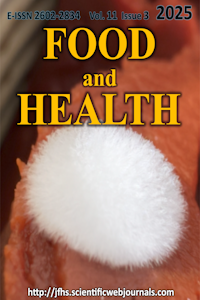Determination of chemical, textural and sensorial properties of civil cheese consumed in Erzurum-Horasan region
Öz
Civil cheese is one of the traditional cheese types widely produced and consumed in the Horasan district of Erzurum. This study aimed to investigate some chemical, textural and sensorial properties of civil Cheese sold in Erzurum-Horasan. In this context, a total of 120 civil cheeses sold in the Erzurum-Horasan region were collected in summer and winter. The samples were analysed in terms of pH, acidity, water activity, protein, fat, salt, ash, dry matter and moisture content, and evaluated in terms of sensory characteristics, instrumental colour and textural profiles. Consequently, although the chemical properties of the traditionally or industrially produced civil cheeses were almost similar, they differed in terms of their structural qualities. Production method and seasonality are the main determinants of chemical and textural characteristics of civil cheeses. Moreover, industrially produced civil cheeses were more palatable than traditionally produced cheeses, and in addition, it was concluded that cheese consumed mainly during the summer months was more valuable than that consumed during the winter months.
Anahtar Kelimeler
Civil cheese Chemical properties Sensorial quality Textural attributes
Etik Beyan
The authors declare that this study does not involve experiments with human or animal subjects, and therefore, ethics committee approval is not required.
Destekleyen Kurum
Research Fund of İstanbul University-Cerrahpaşa
Proje Numarası
TYL-2017-26780
Kaynakça
- AMSA (2012). American Meat Science Association. Meat Color Measurement Guidelines. Champaign, Il. ISBN: 9781300552611
- AOAC (2005). Official methods of analysis of the Association of the Analytical Chemists (17th ed.) (Washington).
- Arslaner, A., Salık, M.A. (2017). Some physicochemical and microbiological characteristics of the Civil cheese put up for sale in Bayburt market. II. International Conference on Advanced Engineering Technologies, 21-23 September 2017, Bayburt, Türkiye.
- Arslaner, A., Salık, M.A. (2020). Some chemical, biochemical, microbiological properties, mineral and heavy metal contents of Bayburt civil cheese. Gıda, 45, 433-447. https://doi.org/10.15237/gida.GD19159
- Atasever, M. (1995). Civil peynirinin üretiminde farklı asitlikteki sütlerin kullanımı ile tuzlama tekniklerinin kaliteye etkisi üzerine bir araştırma [Selçuk University, Institute of Health Sciences, Department of Food Hygiene and Technology, Doctoral Thesis].
- Ayar, A., Akın, N., Sert, D. (2006). Bazı peynir çeşitlerinin mineral kompozisyonu ve beslenme yönünden önemi. Türkiye 9. Gıda Kongresi, 24-26 Mayıs 2006, Bolu, s.319-322.
- Bakırcı, I., Andiç, S. (1998). Muş-Bulanık yöresinde üretilen çeçil peyniri üzerinde Bir araştırma. Yüzüncü Yıl Üniversitesi Veterinerlik Fakültesi Dergisi, 10, 67-71.
- Baran, D., Topçu, Y. (2018). Coğrafi işaretli Erzurum küflü peynirinin tüketici tercihlerine dayalı pazarlama taktik ve stratejileri. Kahramanmaraş Sütçü İmam Üniversitesi Tarım ve Doğa Dergisi, 21(2), 191-202. https://doi.org/10.18016/ksudobil.302230
- Bourne, M.C. (1978). Texture Profile Analysis. Food Technology, 32, 62-66, 72.
- Cakmakci S., Gundogdu E., Hayaloglu A.A., Dagdemir E., Gurses M., Cetin B., Tahmas-Kahyaoglu D. (2012). Chemical and microbiological status and volatile profiles of mouldy Civil cheese, a Turkish mould-ripened variety. International Journal of Food Science and Technology, 47, 2405-2412. https://doi.org/10.1111/j.1365-2621.2012.03116.x
- Cakmakci, S., Salık, M.A. (2021). Türkiye'nin coğrafi işaretli peynirleri. Akademik Gıda, 19(3), 325-342. https://doi.org/10.24323/akademik-gida.1011229
- Cambaztepe, F., Çakmakçı, S., Dağdemir, E. (2009). Effect of some technological parameters on microbiological, chemical and sensory qualities of Civil cheese during ripening. International Journal of Dairy Technology, 62(4), 541-548. https://doi.org/10.1111/j.1471-0307.2009.00536.x
- Çetinkaya, A. (2005). Yöresel Peynirlerimiz. Academic Book Production, Kars, 212. ISBN: 975-921830905
- Demir, M. (2006). Fabrika şartlarında üretilen çeçil peynirlerinin olgunlaşma süresince bazı kalite kriterlerinin belirlenmesi [Atatürk University, Institute of Science and Technology, Department of Food Engineering, Master’s Thesis].
- Dikbaş, N., Şengül, M., Ertugay, M.F. (2006). Erzurum’da Üretilen Çeçil Peynirinin Bazı Fiziksel ve Kimyasal Özelliklerinin Belirlenmesi. Türkiye 9. Gıda Kongresi, 24-26 Mayıs, Bolu, s.161-164.
- Elmalı, G., Uylaşer, V. (2012). Production and properties of cecil cheese as a traditional food. Journal of Agricultural Faculty of Uludag University, 26(1), 83-92.
- Fox, P.F., Guinee, T.P., Cogan, T.M., McSweeney, P.L.H. (2000). Fundamentals of Cheese Science. Aspen Publishers, pp. 19-44. ISBN: ISBN: 978-0834212602
- Guinee, T.P., Fox, P.F. (2017). Salt in Cheese: Physical, Chemical and Biological Aspects, Chapter 13, In Cheese: Chemistry, Physics and Microbiology. Academic Press, pp. 317-375. http://doi.org/10.1016/B978-0-12-417012-4.00013-2
- Gülmez, M., Güven, A. (2001). Kars ilinde satışa sunulan çeçil (civil) peynirlerin bazı mikrobiyolojik ve kimyasal özellikleri. Kafkas Üniversitesi Veteriner Fakültesi Dergisi, 7(1), 63-70.
- Güzeler, N., Koboyeva, F. (2020). Doğu Anadolu Bölgesi’nde üretilen peynir çeşitleri. Osmaniye Korkut Ata Üniversitesi Fen Bilimleri Enstitüsü Dergisi, 3(2), 172-184.
- Hayaloğlu, A.A., Özer, B. (2011). Peynir Biliminin Temelleri. Sidas Medya, pp. 1-12. ISBN: 978-625-439-147-7 Harmankaya S., Harmankaya A. (2020). Investigation of some microbiological and chemical properties of different cheeses. BEU Journal of Science, 9(3), 1389-1400. https://doi.org/10.17798/bitlisfen.658163
- IDF (1980). International Dairy Federation, Milk and Milk Products Guide to Sampling Techniques. IDF 50 A.
- ISO 8586-1 (2012). Sensory Analysis - General Guidance for the Selection, Training and Monitoring of Assessors. Part 1: Selected Assessors. Geneva, Switzerland: International Organization for Standardization.
- ISO 13299 (2016). Sensory analysis - Methodology - General guidance for establishing a sensory profile. Geneva, Switzerland: International Organization for Standardization.
- Kamber, U. (2006). Peynirin tarihçesi. Veteriner Hekimler Derneği Dergisi, 77(2), 40-44.
- Özbay G., Tüysüz V. (2024). Türkiye’nin coğrafi işaretli peynirlerinin fonksiyonel gıdalar kapsamında değerlendirilmesi. Yönetim ve Ekonomi, 31(1), 107-134. https://doi.org/10.18657/yonveek.1288409
- Özdemir, C., Özdemir, S., Çelik, Ş., Dağdemir, E. (2003). Çarzof Civil Peynirinin Mikrobiyolojik ve Kimyasal Özellikleri. Süt Endüstrisinde Yeni Eğilimler Sempozyumu, 22-23 Mayıs 2003, İzmir, s.22-23.
- Polat, G., Yetişmeyen, A., Doğan, H.B. (2001). Ankara piyasasında satılan civil peynirlerinin mikrobiyolojik, kimyasal ve duyusal niteliklerin saptanması. Gıda, 26(6), 409-418.
- Saygılı, D., Demirci, H., Samav, U. (2020). Coğrafi işaretli Türkiye peynirleri. Aydın Gastronomy, 4(1), 11-21. https://doi.org/10.17932/IAU.GASTRONOMY.2017.016/2020.401/gas_v04i1002
- Şengül, M., Gürses. M. (2006). A survey on the some chemical and biochemical properties of Civil cheese, a traditional Turkish cheese. International Journal of Food Properties, 9, 791-801. https://doi.org/10.1080/10942910600596415
- Şengül, M., Değirmenci, M., Erkaya, T. (2009). Compositional and microbiological characteristics during ripening of Cecil cheese, a traditional Turkish cheese. Asian Journal of Chemistry, 21(4), 3087-3093.
- Tekinşen, O.C., Atasever, M., Keleş, A. (1996). Chemical and organoleptical properties of civil cheese. Veteriner Bilimleri Dergisi, 12(1), 65-71.
- TPE (2009). T.C. Türk Patent Enstitüsü, Coğrafi İşaret Tescil Belgesi, Erzurum Civil Peyniri, Tescil No:116, Ankara, Türkiye. https://ci.turkpatent.gov.tr/cografi-isaretler/detay/37987
- Yangılar, F., Kızılkaya, P.Ç. (2015). Ardahan’ın aromatik çeçil peynirlerinin mikrobiyolojik ve kimyasal özelliklerinin belirlenmesi. BEU Journal of Science, 4(2), 122-130. https://doi.org/10.17798/beufen.04274
- Yazici, F., Dervisoglu, M. (2003). Effect of pH adjustment on some chemical, biochemical and sensory properties of civil cheese during storage. Journal of Food Engineering, 56(4), 361-369. https://doi.org/10.1016/S0260-8774(02)00208-X
- Yetişmeyen, A., Polat, G., Doğan, H. (2001). Determination of microbiological, chemical and organoleptic properties of civil cheese sold in Ankara. Gıda, 26(6), 409-418.
- Yetişmeyen, A. (2005). Bazı geleneksel peynirlerimizin biyojen amin içeriğinin saptanması ve peynirlerin mikrobiyolojik, kimyasal özellikleriyle olan ilişkisinin araştırılması, Ankara University, Final Report of Scientific Project, Ankara. Project No. 20030711071. https://bap.ankara.edu.tr/
- Yıldız, F., Yetişmiyen, A., Şenel, E., Durlu Özkan, F., Öztekin, Ş., Şanlı, E. (2010). Some properties of civil cheese: A type of traditional Turkish cheese. International Journal of Dairy Technology, 63(4), 575-580. https://doi.org/10.1111/j.1471-0307.2010.00612.x
Öz
Proje Numarası
TYL-2017-26780
Kaynakça
- AMSA (2012). American Meat Science Association. Meat Color Measurement Guidelines. Champaign, Il. ISBN: 9781300552611
- AOAC (2005). Official methods of analysis of the Association of the Analytical Chemists (17th ed.) (Washington).
- Arslaner, A., Salık, M.A. (2017). Some physicochemical and microbiological characteristics of the Civil cheese put up for sale in Bayburt market. II. International Conference on Advanced Engineering Technologies, 21-23 September 2017, Bayburt, Türkiye.
- Arslaner, A., Salık, M.A. (2020). Some chemical, biochemical, microbiological properties, mineral and heavy metal contents of Bayburt civil cheese. Gıda, 45, 433-447. https://doi.org/10.15237/gida.GD19159
- Atasever, M. (1995). Civil peynirinin üretiminde farklı asitlikteki sütlerin kullanımı ile tuzlama tekniklerinin kaliteye etkisi üzerine bir araştırma [Selçuk University, Institute of Health Sciences, Department of Food Hygiene and Technology, Doctoral Thesis].
- Ayar, A., Akın, N., Sert, D. (2006). Bazı peynir çeşitlerinin mineral kompozisyonu ve beslenme yönünden önemi. Türkiye 9. Gıda Kongresi, 24-26 Mayıs 2006, Bolu, s.319-322.
- Bakırcı, I., Andiç, S. (1998). Muş-Bulanık yöresinde üretilen çeçil peyniri üzerinde Bir araştırma. Yüzüncü Yıl Üniversitesi Veterinerlik Fakültesi Dergisi, 10, 67-71.
- Baran, D., Topçu, Y. (2018). Coğrafi işaretli Erzurum küflü peynirinin tüketici tercihlerine dayalı pazarlama taktik ve stratejileri. Kahramanmaraş Sütçü İmam Üniversitesi Tarım ve Doğa Dergisi, 21(2), 191-202. https://doi.org/10.18016/ksudobil.302230
- Bourne, M.C. (1978). Texture Profile Analysis. Food Technology, 32, 62-66, 72.
- Cakmakci S., Gundogdu E., Hayaloglu A.A., Dagdemir E., Gurses M., Cetin B., Tahmas-Kahyaoglu D. (2012). Chemical and microbiological status and volatile profiles of mouldy Civil cheese, a Turkish mould-ripened variety. International Journal of Food Science and Technology, 47, 2405-2412. https://doi.org/10.1111/j.1365-2621.2012.03116.x
- Cakmakci, S., Salık, M.A. (2021). Türkiye'nin coğrafi işaretli peynirleri. Akademik Gıda, 19(3), 325-342. https://doi.org/10.24323/akademik-gida.1011229
- Cambaztepe, F., Çakmakçı, S., Dağdemir, E. (2009). Effect of some technological parameters on microbiological, chemical and sensory qualities of Civil cheese during ripening. International Journal of Dairy Technology, 62(4), 541-548. https://doi.org/10.1111/j.1471-0307.2009.00536.x
- Çetinkaya, A. (2005). Yöresel Peynirlerimiz. Academic Book Production, Kars, 212. ISBN: 975-921830905
- Demir, M. (2006). Fabrika şartlarında üretilen çeçil peynirlerinin olgunlaşma süresince bazı kalite kriterlerinin belirlenmesi [Atatürk University, Institute of Science and Technology, Department of Food Engineering, Master’s Thesis].
- Dikbaş, N., Şengül, M., Ertugay, M.F. (2006). Erzurum’da Üretilen Çeçil Peynirinin Bazı Fiziksel ve Kimyasal Özelliklerinin Belirlenmesi. Türkiye 9. Gıda Kongresi, 24-26 Mayıs, Bolu, s.161-164.
- Elmalı, G., Uylaşer, V. (2012). Production and properties of cecil cheese as a traditional food. Journal of Agricultural Faculty of Uludag University, 26(1), 83-92.
- Fox, P.F., Guinee, T.P., Cogan, T.M., McSweeney, P.L.H. (2000). Fundamentals of Cheese Science. Aspen Publishers, pp. 19-44. ISBN: ISBN: 978-0834212602
- Guinee, T.P., Fox, P.F. (2017). Salt in Cheese: Physical, Chemical and Biological Aspects, Chapter 13, In Cheese: Chemistry, Physics and Microbiology. Academic Press, pp. 317-375. http://doi.org/10.1016/B978-0-12-417012-4.00013-2
- Gülmez, M., Güven, A. (2001). Kars ilinde satışa sunulan çeçil (civil) peynirlerin bazı mikrobiyolojik ve kimyasal özellikleri. Kafkas Üniversitesi Veteriner Fakültesi Dergisi, 7(1), 63-70.
- Güzeler, N., Koboyeva, F. (2020). Doğu Anadolu Bölgesi’nde üretilen peynir çeşitleri. Osmaniye Korkut Ata Üniversitesi Fen Bilimleri Enstitüsü Dergisi, 3(2), 172-184.
- Hayaloğlu, A.A., Özer, B. (2011). Peynir Biliminin Temelleri. Sidas Medya, pp. 1-12. ISBN: 978-625-439-147-7 Harmankaya S., Harmankaya A. (2020). Investigation of some microbiological and chemical properties of different cheeses. BEU Journal of Science, 9(3), 1389-1400. https://doi.org/10.17798/bitlisfen.658163
- IDF (1980). International Dairy Federation, Milk and Milk Products Guide to Sampling Techniques. IDF 50 A.
- ISO 8586-1 (2012). Sensory Analysis - General Guidance for the Selection, Training and Monitoring of Assessors. Part 1: Selected Assessors. Geneva, Switzerland: International Organization for Standardization.
- ISO 13299 (2016). Sensory analysis - Methodology - General guidance for establishing a sensory profile. Geneva, Switzerland: International Organization for Standardization.
- Kamber, U. (2006). Peynirin tarihçesi. Veteriner Hekimler Derneği Dergisi, 77(2), 40-44.
- Özbay G., Tüysüz V. (2024). Türkiye’nin coğrafi işaretli peynirlerinin fonksiyonel gıdalar kapsamında değerlendirilmesi. Yönetim ve Ekonomi, 31(1), 107-134. https://doi.org/10.18657/yonveek.1288409
- Özdemir, C., Özdemir, S., Çelik, Ş., Dağdemir, E. (2003). Çarzof Civil Peynirinin Mikrobiyolojik ve Kimyasal Özellikleri. Süt Endüstrisinde Yeni Eğilimler Sempozyumu, 22-23 Mayıs 2003, İzmir, s.22-23.
- Polat, G., Yetişmeyen, A., Doğan, H.B. (2001). Ankara piyasasında satılan civil peynirlerinin mikrobiyolojik, kimyasal ve duyusal niteliklerin saptanması. Gıda, 26(6), 409-418.
- Saygılı, D., Demirci, H., Samav, U. (2020). Coğrafi işaretli Türkiye peynirleri. Aydın Gastronomy, 4(1), 11-21. https://doi.org/10.17932/IAU.GASTRONOMY.2017.016/2020.401/gas_v04i1002
- Şengül, M., Gürses. M. (2006). A survey on the some chemical and biochemical properties of Civil cheese, a traditional Turkish cheese. International Journal of Food Properties, 9, 791-801. https://doi.org/10.1080/10942910600596415
- Şengül, M., Değirmenci, M., Erkaya, T. (2009). Compositional and microbiological characteristics during ripening of Cecil cheese, a traditional Turkish cheese. Asian Journal of Chemistry, 21(4), 3087-3093.
- Tekinşen, O.C., Atasever, M., Keleş, A. (1996). Chemical and organoleptical properties of civil cheese. Veteriner Bilimleri Dergisi, 12(1), 65-71.
- TPE (2009). T.C. Türk Patent Enstitüsü, Coğrafi İşaret Tescil Belgesi, Erzurum Civil Peyniri, Tescil No:116, Ankara, Türkiye. https://ci.turkpatent.gov.tr/cografi-isaretler/detay/37987
- Yangılar, F., Kızılkaya, P.Ç. (2015). Ardahan’ın aromatik çeçil peynirlerinin mikrobiyolojik ve kimyasal özelliklerinin belirlenmesi. BEU Journal of Science, 4(2), 122-130. https://doi.org/10.17798/beufen.04274
- Yazici, F., Dervisoglu, M. (2003). Effect of pH adjustment on some chemical, biochemical and sensory properties of civil cheese during storage. Journal of Food Engineering, 56(4), 361-369. https://doi.org/10.1016/S0260-8774(02)00208-X
- Yetişmeyen, A., Polat, G., Doğan, H. (2001). Determination of microbiological, chemical and organoleptic properties of civil cheese sold in Ankara. Gıda, 26(6), 409-418.
- Yetişmeyen, A. (2005). Bazı geleneksel peynirlerimizin biyojen amin içeriğinin saptanması ve peynirlerin mikrobiyolojik, kimyasal özellikleriyle olan ilişkisinin araştırılması, Ankara University, Final Report of Scientific Project, Ankara. Project No. 20030711071. https://bap.ankara.edu.tr/
- Yıldız, F., Yetişmiyen, A., Şenel, E., Durlu Özkan, F., Öztekin, Ş., Şanlı, E. (2010). Some properties of civil cheese: A type of traditional Turkish cheese. International Journal of Dairy Technology, 63(4), 575-580. https://doi.org/10.1111/j.1471-0307.2010.00612.x
Ayrıntılar
| Birincil Dil | İngilizce |
|---|---|
| Konular | Süt Teknolojisi |
| Bölüm | Research Articles |
| Yazarlar | |
| Proje Numarası | TYL-2017-26780 |
| Erken Görünüm Tarihi | 19 Haziran 2025 |
| Yayımlanma Tarihi | |
| Gönderilme Tarihi | 12 Aralık 2024 |
| Kabul Tarihi | 10 Nisan 2025 |
| Yayımlandığı Sayı | Yıl 2025 Cilt: 11 Sayı: 3 |
Journal is licensed under a
CreativeCommons Attribtion-ShareAlike 4.0 International Licence 


Diamond Open Access refers to a scholarly publication model in which journals and platforms do not charge fees to either authors or readers.
Open Access Statement:
This is an open access journal which means that all content is freely available without charge to the user or his/her institution. Users are allowed to read, download, copy, distribute, print, search, or link to the full texts of the articles, or use them for any other lawful purpose, without asking prior permission from the publisher or the author. This is in accordance with the BOAI definition of open access.
Archiving Policy:
Archiving is done according to ULAKBİM "DergiPark" publication policy (LOCKSS).


